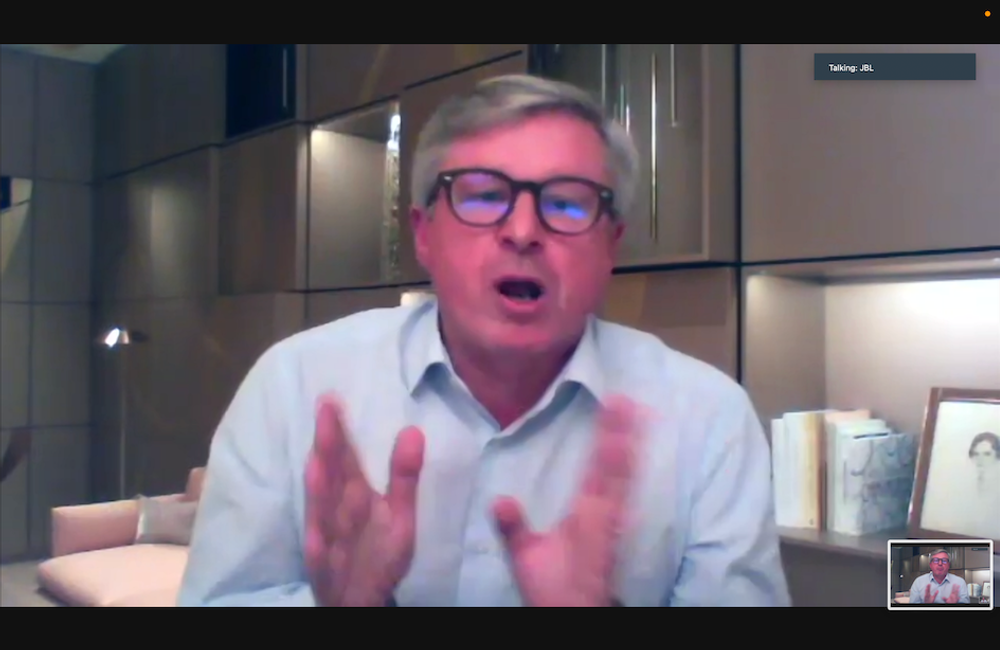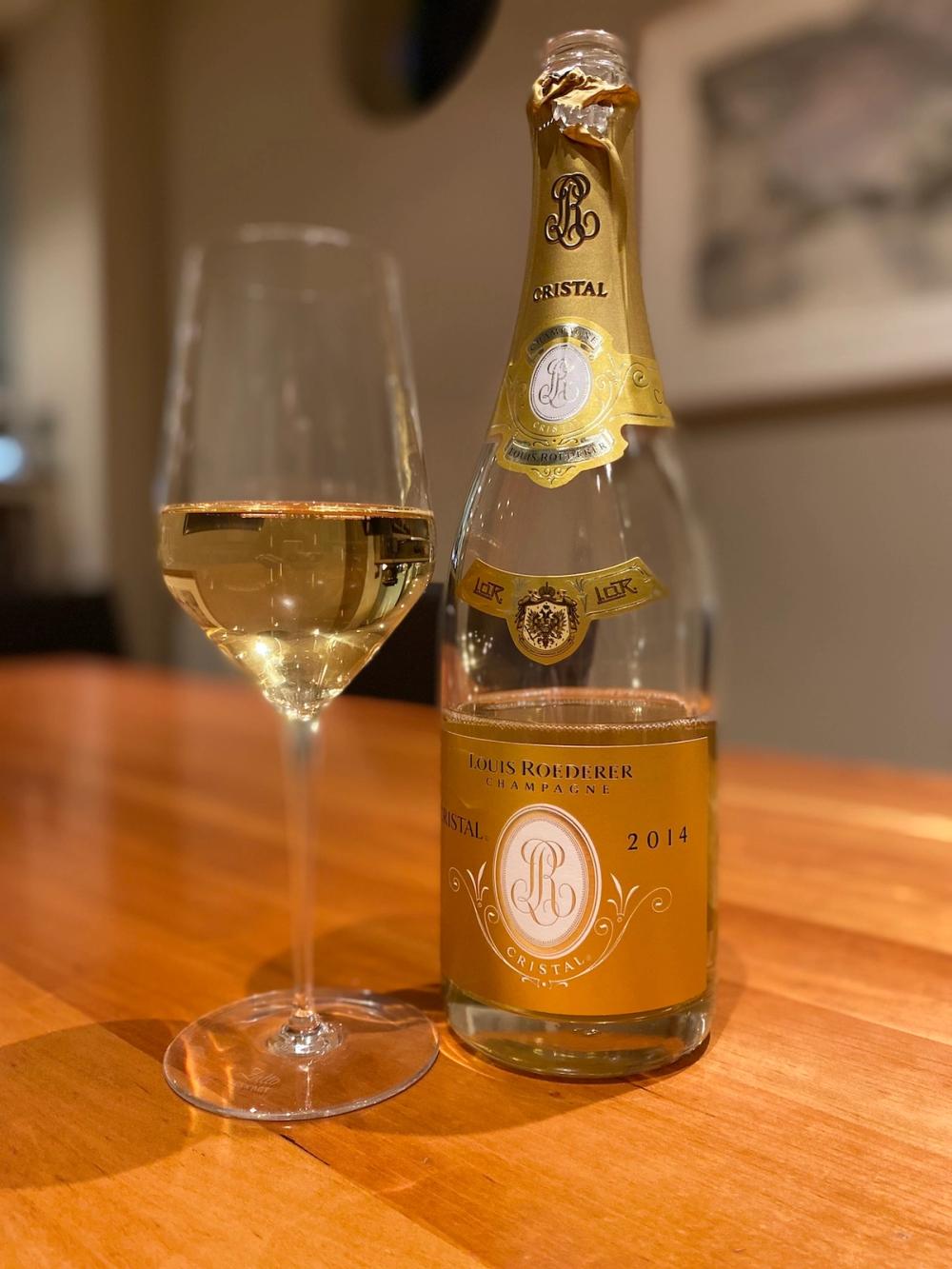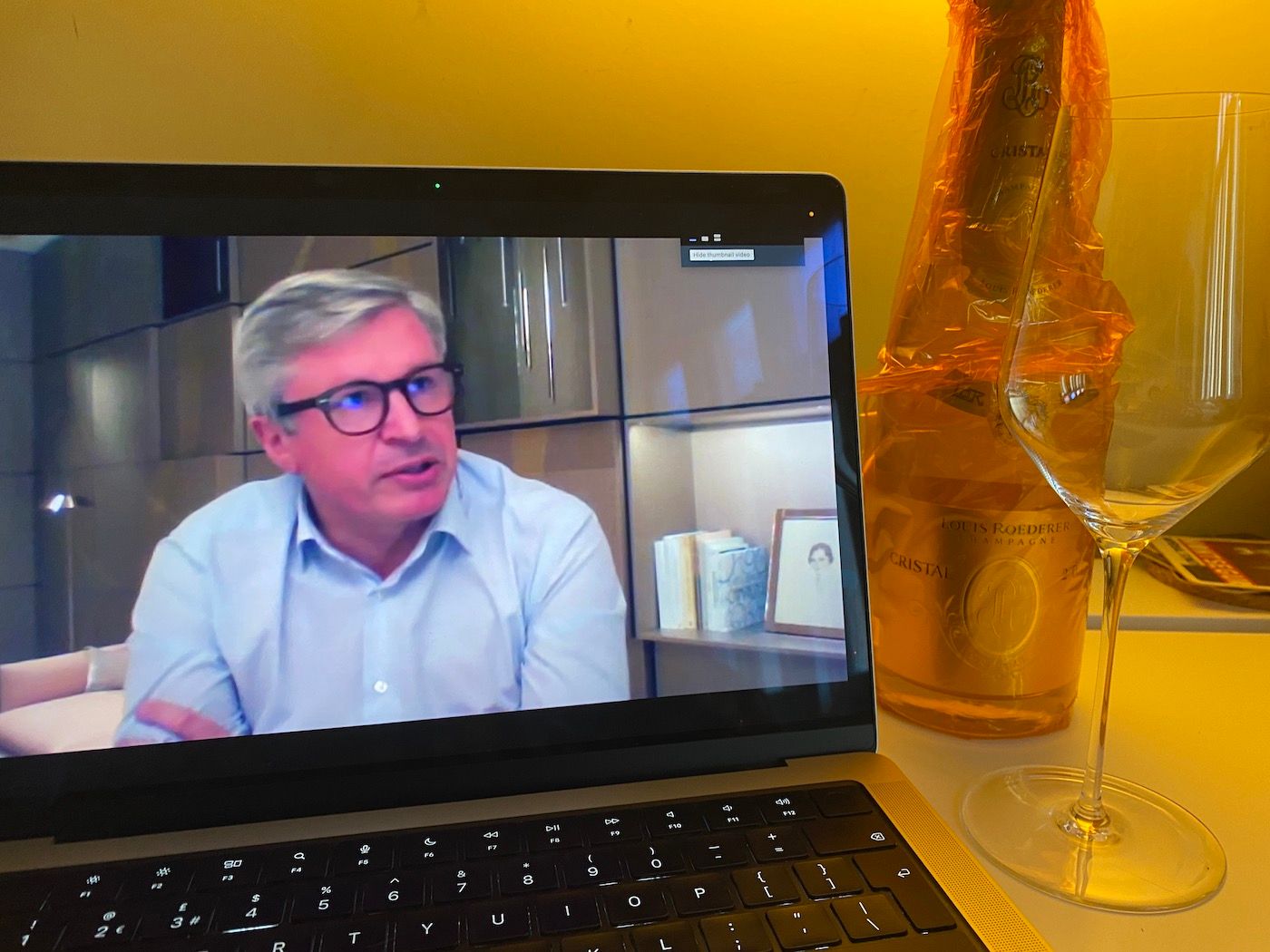“We call it composition – we compose Cristal – it is already written by the estate, we don’t start with a white page the estate is the maestro but the game of composition is can we, with our experience and search for excellence, can we make it better?”
Thirty-three years since taking on one of the most prestigious seats in Champagne, if not the winemaking world, Jean-Baptiste Lécaillon is unashamedly still on a learning curve. His tireless pursuit of perfection was evidenced at the worldwide launch of Cristal 2014 yesterday when he spoke direct from Louis Roederer headquarters where he is chef de cave. Apart from the new cuvée, of course, Lécaillon spoke enthusiastically and at length about a number of areas where he is making significant changes in both the viticulture and winemaking process of Cristal. Throughout he spoke of ‘French flair’ and the need to keep learning, often through mistakes, to understand “what a wine needs and doesn’t need.”
For Cristal 2014 it is the first time he is using ‘jetting’ on its production, the process of sending high pressure into the bottle before corking to remove all oxygen. Jetting has been used to date on Cristal Rosé as a way of preserving the fruit and will be used on Cristal 2014 and the Blanc de Blancs 2014 – giving the wine that reductive, smoky edge. Here he is using it to “shut down a little bit of its expression,” he explains, “It (2014) is a big boy, a strong boy but needs to be shut down a little bit, it is a gifted child but some need to be pushed and others need to be retained.”
Also new is a PCR-based method to detect wine spoilage yeast in order to “root out the bad guys” and to inform the team’s decision-making on when to use wild ferment or cultured yeast.
Lécaillon has also, over the years, increased the percentage of oak used in the ferment to where it now sits at 32% which, in part, is allied to the estate’s full conversion to organic and biodynamic farming, “the journey to more organic… it is understanding what it could bring to our wines,” he says, adding that biodynamicaly-farmed fruit has the ability to ‘suck up’ oak better without any overt oakiness detectable in the wine. Interestingly the 90-hectolitre casks have a ‘white toast’ a technique Lécaillon has been perfecting over the years. Malolactic fermentation has also been cleverly avoided.
Lécaillon is interested in creating the “perfect passport for ageability – having a high dry extract wine, lots of everything – phenoliocs, organic acid, proteins, together with super low Ph (3%) everything is built for ageing.” And this quest for perfection should be seen alongside the experimental strides he has been making with the new Collection multi-vintage wine released last summer which he says shares the same philosophy as Cristal and refers to it as “Cristal in a tank”.

“Winemaking of the 21st century is not trying to ‘print’ your ideas of the wine.” Jean-Baptise Lécaillon, Zoom tasting January 31, 2022
Longterm strategies in viticulture
It is through the viticultural transformation at the estate, that all of this has been made possible. Louis Roederer is unusual in being one of the only large Houses in Champagne to vinify all of its own-farmed, biodynamic fruit, something the ‘grower’ Champenoise have been making a lot of noise about in recent years. And at Cristal this has happened recently. 2008, for example, was made of 40% organic fruit and, with increased percentages comes greater precision, Lécaillon says.
Cristal 2014 is now only the third fully-biodynamic vintage and one which relies on long-term thinking and processes. When a plot is replanted on any of the 45 Cristal Lieu-dits, coming as it does from the House’s conservatories of old massal-selection Pinot Noir and Chardonnay, it is left to take root for 20 years before any of the fruit will be of the sufficient concentration and quality to qualify for use in Cristal – until then the fruit is used for other wines.
Lécaillon is after intense concentration and dry extract in his vin de clair and this is only achieved, he finds, when the roots of the new vines are fully integrated with the bedrock 1.2 metres below.
“It is very soft farming,” he explains, “deep rooted-vines combined with farming that is really dedicated to this deep-rooting and to find the balance of moderate yields, 6-8000 kilos per hectare to get perfect concentration. We replant our plots with this old material (massal selection from pre-clonal time) that has been in our Cristal plots for ages – which is also part of the DNA of Cristal, the singularity of Cristal – which is white soils together with this unique, homemade, I should say at least, home-selected Pinot Noir and Chardonnay massal selection which gives a very specific taste and very specific flavour.”
Coping with climate change
This longterm strategy and use of organic and biodynamic viticulture is key to weathering the storm of rapidly-changing weather patterns. The growing season of 2014 is described as a “weather waltz” in the press handouts although, one suspects, some more prosaic language was used to describe the weather when working in the vineyards. Lécaillon prefers to see rapidly-fluctuating weather as a return to Champagne’s more difficult vintages of the 1990s, although he does admit that Climate Change is bringing clear extremes to the weather.
“The weather asks for more agility in moving from one viticulture to the other, we do two viticultures – continental and oceanic viticulture and they are opposite. For example, with continental we need to keep leaves and protect from sun, oceanic we need to get some sunshine in.”
“So 2014 was one of the years of the ‘new Champagne’ – with clear extremes the weather can change very strongly from one period to another now. And we had in 14 we had a beautiful Spring, very dry, very continental and we had a very oceanic summer with a lot of rain, twice more than usual in the Côte des Blancs and the Valée de la Marne. And then we had this beautiful September that changed everything – we could have lost the vintage mid-August with this very difficult summer but finally thanks to the beautiful weather at the end of August and September we had real summer and real ripeness.”
Lécaillon decided to pick as late as possible in order to get as much concentration and extra dry extract “so important in the texture of Cristal”. His team started picking on September 20 and completed seven days later.
“It is a risk,” he admits, “you have to have a strong team able to pick quickly – we waited for the perfect ripeness and able to go very quickly and pick first the Montagne de Reims (that was not so affected by the summer rain). I love picking after four or five days of shrivelling it is the perfect moment you get full flavours and get the start of concentration without going too far like some 2002 did – you get a little bit big – but you need concentration. It is why I waited for the last evaporation in the second week of September.”

Why 2014 is a wine of soil
None of this would not have been possible without the House’s eco-friendly viticulture but the real ‘key’ to the vintage lay in the soils, the drainage properties of the chalk on the lower-middle part of the hillside helped with the excess water from the summer to drain away which, in turn, limited excess vigour in the vines.
“It is a wine of soil not of climate,” Lécaillon continues, “it is capturing the energy of the soil and chalk (which is the Cristal story). In this vintage 2014 I think the soil is even more important. The vintage was wet in summer with this oceanic weather – and the soil was really important to percolate, to stamp the climate, it is this magnificent magic tool we have in Champagne, in dry years to give more water to the vines and in very wet summers to fix the water and really keep the root dry enough for the vines not to suffer too much water or too much dilution.”
“Chalk is the essence of Cristal and in 1876 the original idea was to catch these magificent, unique white soils of Champagne that bring a lot of finesse and character to the wine.”
45 plots are selected for Cristal, seven Grand Cru, and as all are being vinified separately Lécaillon and his team attempt to eliminate wines in order to reach ‘perfection’. Of the 45, six were eliminated in 2014 with all of the Montagne de Reims plots making the final ‘cut’ as the vineyards had been less affected by rain and ripened first.
“We call it composition – we compose Cristal – it is already written by the estate, we don’t start with a white page the estate is the maestro but the game of composition is can we, with our experience and search for excellence, can we make it better?”
“We try and make the domaine shine and these white soils express themselves in total purity – I use the image of white soils, a beautiful summer morning where it is cool – white soils with blue sky – without any cloud this should be the Cristal when we bottle it, it should be perfection. Winemaking of the 21st century is all about catching the purity of the place and bottling that for everyone not trying to ‘print’ your ideas of the wine. You have to be behind the wine, it is why oak is behind (people don’t taste it) as it plays its role but it’s not visible – everything should be behind the terroir and chalk.”
Comparisons with the 2012 vintage
When comparing the finished wines Lécaillon recalls the 2012 vintage.
“It is showing a lot, 2014 is a very expressive wine – very complex fruit, flavours and richness of aromatics – but it has more freshness than 2012, more precise definition, more pixels in 14 than 12. It is a beautiful vintage and I have not seen this beauty when so young, I didn’t imagine it would show this so early from release.”
With alcohol in the fermented wines coming in at just over 11% for both the Pinot Noir and Chardonnay (which make up the customary 60/40% in the final blend), no chapitalisation was necessary, no malolactic, and the wine has kept as much of its natural balance, freshness and energy as possible – 32% fermented in oak.
“It has been like that for the last six or seven vintages – because more organic and biodynamic wines can take more and more oak – it stretches the length of the wine – you get oak tannins, a longer profile.”
“Seven or eight years ago oak would have added sweetness but I don’t think this is what oak brings now it brings tannin and dry finish, it stretches, it gives it a longer finish, it drives your palate and makes the finish even longer.”
Lécaillon also says that there is a misconception that big wines cannot take oak.
“Big wines love oak, the finish is stretched by the oak – Chardonnay (especially) is an ‘oak-matcher’ it loves oak you can play a lot with oak on Chardonnay, Pinot Noir you have to be careful because if you want fruity Pinot Noir if you want acidify-fruit-Pinot Noir you have to be careful with oak because oak shuts it down.”
“Malic plays a role, for sure, and it’s even more important this role of contrast… you always need to contrast what nature gives you – if it gives you ripeness play a cool and soft fermentation, if it gives a cool year then play it warm – you have to give the wine the opposite of what he has in its DNA, it is like food.”
When asked at the end of this interview how he would sum up Cristal to the uninitiated he referenced the work and the craftsmanship “the long term attention to details, the passion that is behind passion – and a little bit of poetry as well – I have always thought that Cristal being created in 1876 has a bit of Baudelaire about it – Les Fleurs du mal is sitting somewhere in Cristal – this invitation to the voyage from Baudelaire is an important idea of Cristal.”
So how is Cristal 2014 tasting?

Intense shiny gold to look at; energetic mousse with a vigorous fine bead of bubbles. The bouquet is intense and inviting, it offers immediate depth and complexity, the concentration and ripeness of the fruit, autolytic qualities – savoury notes, a slight smokiness, grain, nuts – along with chalky freshness, briny oyster shell, and ripe orchard fruit, a suggestion of wild fennel flower.
On the palate there’s a hit of apple and sea spray on first taste, the initial attack is rounded (by Cristal standards) and reflective of where this vintage and the House is taking the wine into earlier drinkability, the bubbles are soft and nicely integrated; then the balance is felt mid-palate beautifully poised between late, lush, ripe orchard fruit, and mineral-driven, steely acidity with citrus also on the pedal. This a detailed wine with pixilated hits of grapefruit pith, crisp green apple, dried apple slices, salty crumb. The texture is gastronomic, chalky fresh, powdery tannins, and really quite delightful.
It doesn’t quite reach the dizzying ‘symphonic’ heights of 2013 but Cristal 2014 is still a beautifully composed concerto – a brilliantly delivered Champagne in three movements – the bright balanced attack, the complex and concentrated mid-palate and then this extraordinary length, that plays infinitesimally like the final chord of A Day in the Life. Quite a ‘journey’ and one which you will be more can happy to let Cristal 2014 take you on.
Key data:
Fruit sourced equally from La Rivière, La Montagne and La Côte vineyards
Main crus: Verzenay, Verzy, Beaumont-sur-Vesle, Ay, Avize, Mesnil-sur-Oger, Cramant
60% Pinot Noir, 40% Chardonnay
Dosage 7 g/l, 32% in oak, 0% malolactic
Retail price: £250-60









































